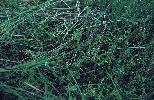Species profile—Myriophyllum artesium
Classification
Plantae (plants) → Equisetopsida (land plants) → Haloragaceae → Myriophyllum artesium

Go to Photo gallery
Sighting data
Species details
- Kingdom
- Plantae (plants)
- Class
- Equisetopsida (land plants)
- Family
- Haloragaceae
- Scientific name
- Myriophyllum artesium Halford & Fensham
- WildNet taxon ID
- 27450
- Nature Conservation Act 1992 (NCA) status
- Least concern
- Conservation significant
- No
- Confidential
- No
- Wetland status
- Wetland Indicator Species
- Endemicity
- Native
- Pest status
- Nil
- Description
- Myriophyllum artesium is a creeping mat-forming herb, growing to 15 cm high, with erect flowering unbranched stems, which arise from a tangled mat of prostrate rhizomatous stems. All stems are slender and about 0.8 mm in diameter. The prostrate stems root freely at the nodes. The leaves are monomorphic, opposite (rarely, a few alternate on fast growing stems), oblanceolate to narrowly obovate or narrowly elliptic to elliptic, 3.3 to 5.5 mm long by 1.2 to 2.9 mm wide, obtuse or attenuate at base. The leaf margins are entire, the tip is blunt with a small red terminal gland, and the midrib is obscure. A very small (0.1 mm) hydathode is present on each side of the base of the leaf. The plants are dioecious (individual stems either male or female). The inflorescence is a simple spike with the flowers borne singly in the axils of the leaves. The bracteoles are sexually dimorphic. Bracteoles of male flowers ovate to broad ovate, 0.6 to 1mm long by 0.4 to 0.6 mm long, with a tip which is acute to obtuse. The bracteoles of female flowers are ovate to lanceolate, 0.6 to 0.8mm long by 0.2 to 0.3mm wide, with entire margins and an acute tip. The male flowers are 4-merous, on pedicels 2 to 3.5 mm long at anthesis. The sepals are absent. There are four petals, which are maroon distally, 1.8 to 3 mm long by 0.9 to 1 mm wide, hooded, not keeled or unguiculate, with a rounded tip. There are eight stamens, with the filaments 1 to 1.2 mm long. The anthers are linear-oblong, 1.4 to 1.7 mm long by 0.4 mm wide, non-apiculate. The styles and ovary are absent. Female flowers 4-merous, sessile. The sepals, petals and stamens are absent. Styles 4, sessile; stigmas white, fimbriate. The fruit is sessile, pale brown, cubic (slightly longer than wide), 0.7 to 0.9 mm long and 0.7 mm in diameter (Halford and Fensham, 2001).
M. artesium resembles M. implicatum in its habit, monomorphic leaves and to some extent its fruit sculpturing. However, it differs in having opposite eaves which are oblanceolate to narrowly obovate or narrowly elliptic to elliptic in outline and generally broader, stouter flowering stems, light brown mericarps, and longer pedicels on male flowers at anthesis. M. artesium is similar to M. pedunculatum and M. amphibium in having opposite leaves and relatively robust stems. However, M. artesium is easily distinguished from them by being dioecious; the absence of sepals in male flowers; the mericarp shape and the sculpturing on the dorsal surface. M. artesium can be distinguished from M. lophatum and M. austropygmaeum by the papillate sculpturing on the mericarps and shorter pedicels on male flowers at anthesis (2.0 to 3.5 mm long for M. artesium; greater than 4.0 mm long for M. lophatum and M. austropygmaeum) (Halford and Fensham, 2001). - Distribution
- Myriophyllum artesium occurs in central and southern Queensland, where it has been collected from the Boulia, Clermont - Aramac, Taroom, Quilpie, and Eulo districts. The species is recorded on Doongmabulla Mound Springs Nature Refuge and Elizabeth Springs Conservation park (Halford and Fensham, 2001; Queensland Herbarium, 2012).
- Distributional limits
- -22.0906108, 140.5837013
-28.3356853, 150.2518828 - Range derivation
- Range derived from extent of the taxon's verified records
- Habitat
- Myriophyllum artesium is generally restricted to the wetlands associated with springs emanating from the Great Artesian Basin and associated basins. There are also two collections where the species was recorded having colonised a creek-line fed by permanent artesian water emanating from a running bore (Halford and Fensham, 2001; Queensland Herbarium, 2012).
- Reproduction
- Flowers of Myriophyllum artesium have been recorded in February-March and November; fruits have been recorded in February (Halford and Fensham, 2001; Queensland Herbarium, 2012).
- Threatening processes
- Threats to Myriophyllum artesium include: inappropriate grazing regimes, feral pigs, changes in flow regimes and drainage of habitat (DERM, 2010a; DERM 2010b; DERM, 2010c; DERM, 2010d).
- Status notes
- Myriophyllum artesium is listed as Endangered under the Queensland Nature Conservation Act 1992.
- Management recommendations
- Management strategies and recommendations are outline in DERM (2010a), DERM (2010b), DERM (2010c) and DERM (2010d).
- References
- Halford, D. and Fensham, R.J. (2001). A new species of Myriophyllum L. (Haloragaceae) from artesian springs in Queensland. Austrobaileya 6 (1): 133-137.
Queensland Department of Environment and Resource Management (DERM) (2010a). Burdekin Natural Resource Management Region Back on Track Actions for Biodiversity. Department of Environment and Resource Management, Brisbane.
Queensland Department of Environment and Resource Management (DERM) (2010b). Desert Channels Back on Track Actions for Biodiversity. Department of Environment and Resource Management, Brisbane.
Queensland Department of Environment and Resource Management (DERM) (2010c). Fitzroy Natural Resource Management Region Back on Track Actions for Biodiversity. Department of Environment and Resource Management, Brisbane.
Queensland Department of Environment and Resource Management (DERM) (2010d). South West Natural Resource Management Region Back on Track Actions for Biodiversity. Department of Environment and Resource Management, Brisbane.
Queensland Herbarium (2012). Specimen label information. Queensland Herbarium. Accessed 16/05/2012. - Profile author
- Lynise Wearne (16/05/2012)
Other resources
Data source
This profile data is sourced from the QLD Wildlife Data API using the Get species by ID function used under CC-By 4.0.
https://apps.des.qld.gov.au/species/?op=getspeciesbyid&taxonid=27450.
This information is sourced from the WildNet database managed by the Queensland Department of Environment and Science.



